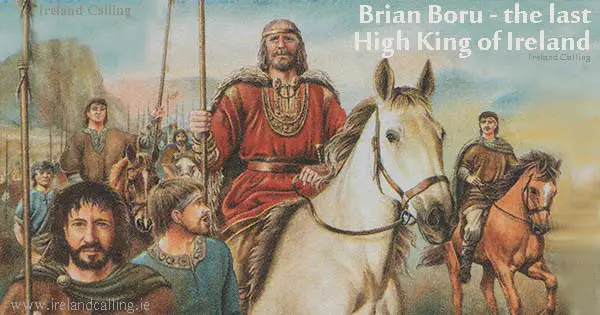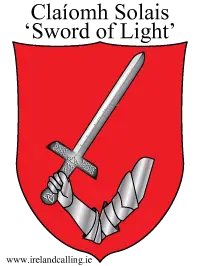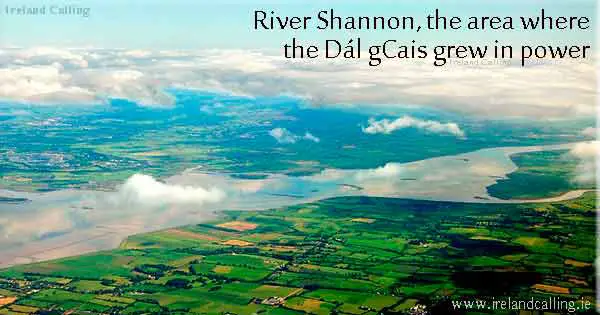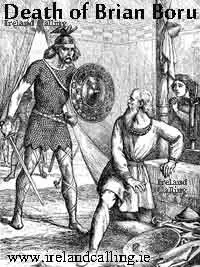Brian Boru was king of the Dál gCais dynasty. He was probably the most successful warlord king in Irish history.

He is known as the last High King of Ireland and is even credited with seeing off the Vikings who had terrorised the Irish for over 200 years.
Neither of those achievements is entirely true. History has slightly exaggerated Brian’s accomplishments.
However, it is true that he ruled more of Ireland than any king that followed him and that his victory in the Battle of Clontarf was an important factor in the demise of the Vikings.
The Dál gCais
The Dál gCais was once a minor kingdom. It ruled over the northern shore of the Shannon estuary, near the modern city of Limerick.

The dominant power in the south of Ireland was the Eóganachta dynasty that ruled over Munster. The Eóganachta were involved in a continuous power struggle with the Uí Néill from the North.
The Eóganachta had success throughout various stages of the conflict but finally bit off more than they could chew in AD 908 when King Cormac mac Cuilennáin took on the combined forces of Uí Néill king, Flann Sinna, and King of Leinster, Cerball mac Muirecáin.
The Eóganachta were defeated and devastated. As well as failing to expand their territory, they also lost much of their power in Munster.
This gave other powers the opportunity to flex their muscles. In 963, the once tiny kingdom of the Dál gCais captured Cashal. It set the stage for five decades of expansion.
Brian becomes King of The Dál gCais

In 976 King Mathgamain mac Cennétig died and his brother Brian took over as King of the Dál gCais. The following year, Brian defeated the Norse Vikings in Limerick. Then in 978 the Dál gCais defeated the Eóganachta and Brian was recognised as King of Munster.
As the dominant ruler in the south of Ireland, Brian looked to expand. However, he ran into the same problem that had thwarted the Eóganachta for the centuries.
The Uí Néill had been unable to capitalise on the fall of the Eóganachta as the Dál gCais had, but they were still the dominant force in the north and were not about to give up their borders.
In 980, the Uí Néill King Máel Seachnaill took control of the Viking town of Dublin and briefly became High King of Ireland.
However, King Máel soon lost control of Dublin and had to turn his attention to the new threat posed by King Brian. After 17 years of tensions and conflict, the two kings met and agreed that Brian would rule over the south of Ireland and Máel would rule over the north.

Brian increases his power
The agreement lasted for only two years and in 999, Brian defeated a coalition of the Ulster Uí Néill and the Dublin Vikings. In 1001, Brian finally defeated his rival Máel. Máel was no longer able to put up any resistance after he was abandoned by his allies including the northern branch of his own dynasty, the Uí Néill.
Over the next decade, Brian continued to take more territories and gain more control over the country.
As Brian took more territories, Ireland began to be at peace because having only one ruler meant there were no major conflicts. Brian toured the country in 1005.
He took tributes from smaller kingdoms and used the money to give gave gifts to the church, to scholars and to the needy. He became known as Brian Boru which meant ‘Brian of the tributes’ (from the Irish bóruma which meant ‘of the cattle tributes’).
High King of Ireland
By 1011 he was recognised as the High King of Ireland, although most scholars believe this grand title wasn’t quite accurate.
It was true that he controlled more of Ireland than any king ever would again but his power was illegitimate and gained through force. He didn’t rule from a base in the capital, nor did he have a formalised revenue raising system.
He had made a lot of enemies during his rise and at the first sign of weakness there would be rulers of smaller kingdoms ready to rise up.
Máel Mórda was King of Leinster and didn’t like answering to Brian. In 1013, during a visit to pay homage to the High King, Mórda was insulted by Brian’s son and left without a word.
Brian sent one of his men to bring Mórda back but Mórda was so angry that he killed the messenger. Mórda decided that Leinster would no longer submit to Brain and was ready for war. He managed to outbid Brian for the support of the Dublin Vikings.
Sitric Silkenbeard was king of the Dublin Vikings and he and Mórda sent for fleets of Vikings from Britain to help them in their battle.

The Battle of Clontarf
At this point the pieces were in place for the Battle that is remembered for bringing down two of the great powers of this period in Ireland’s history – Brian Boru and the Vikings.
Brian died at the Battle of Clontarf as did his son and Grandson. Máel Mórda King of Leinster also died.
Brian’s men won the battle, after several hours they overpowered the Vikings. Brian was killed by Brodir, the Viking leader of the Isle of Man. Brodir found Brian praying in a tent and killed him by striking him in the head with an axe.
The Vikings’ defeat in the Battle of Clontarf is often seen as the end of their power and presence in Ireland. However, while it certainly reduced their power, the truth was that they had been losing their grip over Ireland for decades.
The Vikings weren’t banished from Ireland and they continued to live there for generations. Although they had little power and eventually integrated with the native Irish.
Without a High King, Ireland went back to being a country full of little kingdoms, continuously at war with each other.
More Irish history articles
The Celts were not first people to live in Ireland – who was here before?
The Neolithics – first people to leave their mark on Ireland
https://ireland-calling.com/irish-potato-famine/
Easter Rising 1916 – six days that changed course of history